-
Bahasa Indonesia
-
English
Oleh: Vincent Gaspersz, Lean Six Sigma Master Black Belt & Certified Management System Lead Specialist
- APICS (www.apics.org) Certified Fellow in Production and Inventory Management (CFPIM) and Certified Supply Chain Professional (CSCP);
- International Quality Federation (www.iqf.org) Six Sigma Master Black Belt (SSMBB);
- ASQ (www.asq.org) Certified Manager of Quality/Organizational Excellence (CMQ/OE), Certified Quality Engineer (CQE), Certified Quality Auditor (CQA), Certified Six Sigma Black Belt (CSSBB), Certified Quality Improvement Associate (CQIA);
- Registration Accreditation Board (www.exemplarglobal.org) Certified Management System Lead Specialist (CMSLS).
Abstrak
Strategi peningkatan dan pemerataan pendapatan masyarakat Korea Selatan yang dilakukan melalui koperasi-koperasi yang mengelola bisnis mereka dalam suatu manajemen ke-SISTEM-an industri yang kuat, kapabel, handal, produktif dan berkualitas dapat dijadikan teladan untuk membangun koperasi-koperasi yang mencapai skala usaha ekonomis (economies of scale) dan ruang lingkup ekonomis (economies of scope) baik di Indonesia pada umumnya maupun di Nusa Tenggara Timur pada khususnya.
Pendekatan yang cocok untuk memecahkan masalah pembangunan sumber daya manusia di NTT, adalah mengintegrasikan bidang-bidang ekonomi, pendidikan dan pelatihan, serta kesehatan dan gizi secara terpadu (terintegrasi) dalam kerangka pendekatan sektoral (sektor-sektor produksi) dan pendekatan regional (kabupaten-kabupaten, kecamatan-kecamatan, dan desa-desa) secara utuh sebagai satu sistem perekonomian berbasis koperasi-koperasi yang mencapai skala usaha ekonomis (economies of scale) dan ruang lingkup ekonomis (economies of scope).
I. Terminologi dan Definisi
- Pembangunan ekonomi adalah proses di mana suatu bangsa meningkatkan ekonomi, politik, dan kesejahteraan social rakyatnya. Istilah ini telah digunakan oleh ekonom, politisi, dan lainnya selama ini. Modernisasi, terutama industrialisasi adalah istilah-istilah lain yang telah digunakan banyak orang ketika mendiskusikan pembangunan ekonomi. Sedangkan pertumbuhan ekonomi (economic growth) mencakup usaha intervensi kebijakan pemerintah yang bertujuan meningkatkan perekonomian dan kesejahteraan sosial masyarakat melalui pertumbuhan ekonomi yang ditandai dengan peningkatan produktivitas tenaga kerja dan peningkatan produk domestik bruto (PDB). Dengan demikian kita dapat menyatakan dalam sistem ekonomi, bahwa pembangunan ekonomi yang merupakan proses dari sistem ekonomi itu akan menghasilkan output berupa pertumbuhan ekonomi (peningkatan produktivitas tenaga kerja dan peningkatan produk domestik bruto).
- Koperasi (Cooperative) adalah usaha bersama yang dimiliki dan dijalankan secara bersama oleh anggota-anggotanya yang membagi keuntungan atau manfaat. Charles E. Snyder (President and CEO National Cooperative Bank, 2016) menyatakan bahwa koperasi yang berkualitas dan kompetitif harus memenuhi tujuh persyaratan berikut: (1) Bersifat sukarela dan keanggotaan terbuka, (2) Pengendalian oleh anggota-anggota secara demokratis, (3) Partisipasi ekonomi aktif oleh anggota-anggota, (4) Otonomi dan bebas, (5) Memiliki pendidikan, pelatihan dan informasi, (6) Memiliki kerjasama di antara unit-unit koperasi, dan (7) Mempunyai perhatian pada masyarakat.
- Skala Usaha Ekonomis (Economies of Scale) adalah keunggulan biaya (cost advantages) yang diperoleh satu unit usaha, karena usaha itu beroperasi pada skala output yang memungkinkan dicapainya penurunan biaya per unit output (biaya rata-rata) mencapai minimum. Hal ini disebabkan biaya tetap (fixed costs) akan terdistribusi secara merata sepanjang skala usaha ekonomis itu, sehingga Long Run Average Cost (LRAC) akan minimum. Skala usaha ekonomis ini ada dalam dunia nyata, sehingga setiap unit usaha harus berupaya mendekati atau mencapai skala usaha ekonomis (economies of scale) ini seperti ditunjukan dalam Bagan 1.
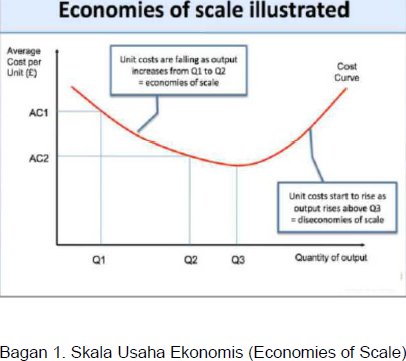
- Ruang Lingkup Ekonomis (Economies of Scope) adalah efisiensi yang tercapai karena proses diversifikasi usaha yang muncul ketika bisnis itu saling memadukan atau mengintegrasikan fungsi-fungsi terkait (misalkan fungsi keuangan atau pemasaran dipadukan menjadi satu) atau ketika unit-unit bisnis saling berintegrasi satu sama lain (misalkan output dari satu unit bisnis menjadi input bagi unit bisnis lain dalam keterkaitan proses bisnis, misal: usaha peternakan sapi potong diintegrasikan dengan usaha pengolahan daging sapi menjadi produk daging beku atau lainnya). Proses konglomerasi dalam unit-unit bisnis adalah berupaya mencapai Ruang Lingkup Ekonomis (Economies of Scope). Penjualan Silang (Cross Selling) berbagai produk sekaligus juga merupakan upaya mencapai Ruang Lingkup Ekonomis (Economies of Scope), karena penjualan berbagai jenis produk akan lebih menguntungkan dibandingkan penjualan hanya satu produk saja. Ruang Lingkup Ekonomis (Economies of Scope) juga dapat beroperasi melalui efisiensi distribusi, misalnya kapal pengangkut akan fleksibel dan efisien ketika mengangkut berbagai jenis produk untuk diangkut ke berbagai lokasi dibandingkan hanya mengangkut satu jenis produk ke satu lokasi saja. Contoh Ruang Lingkup Ekonomis (Economies of Scope) ditunjukan dalam Bagan 2.
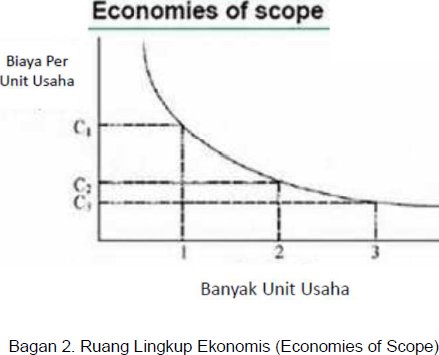
II. Keberhasilan Pembangunan Ekonomi Melalui Koperasi (Pembelajaran dari Korea Selatan)
Korea Selatan merdeka pada tanggal 15 Agustus 1945 (meskipun baru mulai dirayakan pada 15 Agustus 1948) sedangkan Indonesia merdeka pada tanggal 17 Agustus 1945. Mengapa Indonesia harus dibandingkan dengan Korea Selatan, yang tingkat kemajuannya telah jauh melampaui Indonesia? Karena kedua negara ini memulai pembangunan secara bersamaan dan merdeka juga dalam waktu yang hamper bersamaan. Kedua negara ini, Indonesia dan Korea Selatan adalah negara-negara yang jumlah penduduknya miskin ketika memulai pembangunan ekonomi dan industri (perbedaan pada Indonesia kaya akan sumber daya alam vs. Korea Selatan miskin akan sumber daya alam). Namun kedua negara ini berbeda seperti bumi dengan langit pada tahun 2017 ini.
Korea Selatan pada tahun 1960 merupakan negara miskin (pendapatan per kapita USD 79) dengan tanpa sumber daya alam yang memadai, namun melalui penerapan strategi industrialisasi berorientasi ekspor yang ditunjang oleh fokus pembangunan pada sumber daya manusia dalam wadah koperasi secara intensif dan meluas sehingga mampu meningkatkan produktivitas sumber daya manusia nasional Korea Selatan secara dramatis, sehingga telah membawa Korea Selatan pada tahun 2016 telah berpendapatan per kapita USD 25.458,90
(https://tradingeconomics.com/south-korea/gdp-per-capita), naik sekitar 322 kali dalam 56 tahun.
Sedangkan Indonesia yang memiliki sumber daya alam berlimpah pada tahun 2016 hanya berpendapatan per kapita USD 3.974,10
(https://tradingeconomics.com/indonesia/gdp-per-capita).
Pada tahun 1960-an, Indonesia, Malaysia, dan Korea Selatan memulai pembangunan dengan status sama-sama menjadi negara miskin. Perbedaan pada Indonesia kaya sumber daya alam, Malaysia cukup sumber daya alam, dan Korea Selatan miskin sumber daya alam. Namun dalam pembangunan karena faktor pertumbuhan produktivitas sumber daya manusia yang luar biasa telah membawa Korea Selatan menjadi negara berpendapatan tinggi, sedangkan Indonesia menjadi negara berpendapatan menengah. Analisis oleh Vincent Gaspersz (2014) menunjukkan bahwa faktor yang membawa kesejahteraan masyarakat suatu negara tergantung pada peningkatan produktivitas sumber daya manusia, BUKAN kepemilikan sumber daya alam. Produktivitas sumber daya manusia Korea Selatan (tertinggi), Malaysia (sedang), dan Indonesia (rendah) selama periode pembangunan ekonomi tahun 1967-2012 ditunjukan dalam Bagan 3.
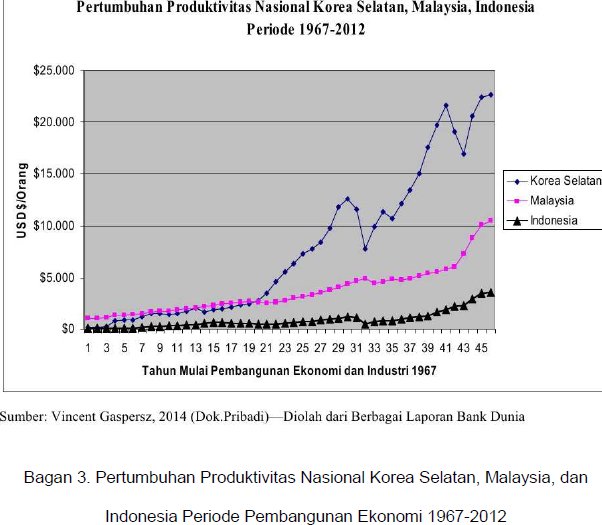
Bank Dunia mengklasifikasikan negara-negara di dunia sebagai berikut:
- Negara berpendapatan rendah memiliki pendapatan per kapita US$975 atau kurang;
- Negara berpendapatan menengah bawah memiliki pendapatan per kapita dari US$976 sampai US$3.855.
- Negara berpendapatan menengah atas memiliki pendapatan per kapita dari US$3.856 sampai US$11.905.
- Negara berpendapatan tinggi memiliki pendapatan per kapita lebih dari US$11.906.
Indonesia yang memiliki sumber daya alam berlimpah pada tahun 2012 hanya menghasilkan Produksi Nasional (Produk Nasional Bruto = GNP/Gross National Product) sebesar USD 844 Milyar, sedangkan Korea Selatan yang miskin sumber daya alam mampu menghasilkan Produksi Nasional (Produk Nasional Bruto = GNP) USD 1,133 Milyar (USD 1,13 Trilyun) atau sekitar 1,34 kali dari GNP Indonesia.
Persentase penduduk miskin di Korea Selatan yang berpenghasilan <= USD 2,5/hari = 0%, demikian pula persentase penduduk miskin berpendapatan USD10/hari adalah nol persen.
Melihat lebih jauh tentang pembangunan kesehatan di Korea Selatan, berdasarkan data Bank Dunia (2014), tingkat kematian bayi (di bawah lima tahun) di Korea Selatan adalah 5/1000 kelahiran, sedangkan di Indonesia adalah 32/1000 kelahiran. Angka kematian ibu melahirkan, di Korea Selatan: 16/100.000, sedangkan di Indonesia 220/100.000. Umur harapan hidup di Korea Selatan 81 tahun, sedangkan di Indonesia 71 tahun.
Bagaimana dengan pembangunan pendidikan di Korea Selatan vs. Indonesia? Data Bank Dunia (2014) menunjukkan persentase penduduk yang memperoleh pendidikan tinggi di Korea Selatan 17,9% sedangkan Indonesia hanya 1,17%.Persentase penduduk berpendidikan menengah di Korea Selatan 36,8% sedangkan di Indonesia hanya 11,1%.
Tentang tingkat tabungan penduduk di Korea Selatan vs. Indonesia adalah: persentase jumlah penduduk yang menabung di Korea Selatan adalah 46,9%; sedangkan di Indonesia hanya 15,3%.
Lebih jauh jika dikaji angka indeks Worldwide Governance Indicators Average (WGIA) di Korea Selatan sebesar +0,76 (positif) sedangkan di Indonesia -0,46 (minus).Bank Dunia menyusun WGIA berdasarkan enam indikator kunci yang menghasilkan angka indeks dari minus 2,5 (terburuk) sampai positif 2,5 (terbaik). Keenam indikator kunci itu adalah: (1) Demokrasi dan Akuntabilitas, (2) Kestabilan Politik dan Ketiadaan Kekerasan, (3) Efektivitas Pemerintahan, (4) Kualitas Peraturan, (5) Penegakan Hukum, dan (6) Pengendalian Korupsi.
Berdasarkan data Bank Dunia (2014) diketahui bahwa indeks WGIA dari Indonesia sebesar -0,46 (minus 0,46) adalah hampir sama dengan Negara-negara Filipina (-0,49), Mali (-0,49), Boznia & Herzegovina (-0,43), dan Tanzania (-0.36).
Negara-negara yang memiliki WGIA Index terburuk adalah: Somalia (-2,30), Afghanistan (-1,75), Sudan (-1,60), Zimbabwe (-1,47), dan Irak (-1,34). Sedangkan Negara-negara yang memiliki WGIA Index terbaik adalah: Denmark (+1,86), Finlandia (+1,85), New Zealand (+1,83), Sweden (+1,80), Switzerland (+1,71), Belanda (+1,71),Norwegia (+1,70), Australia (+1,63), Canada (+1,62), Singapore (+1,47), dan Jerman (+1,42).
Mengapa Korea Selatan bisa maju sangat pesat dibandingkan Indonesia? Ternyata strategi pembangunan ekonomi melalui koperasi yang memiliki skala usaha ekonomis (economies of scale) dan ruang lingkup ekonomis (economies of scope) beserta program Gerakan Masyarakat Baru berikut yang memajukan Korea Selatan.
III.1 Koperasi Pertanian (NACF) di Korea Selatan
Korea Selatan memulai pembangunan melalui melakukan Land Reform secara besar-besaran, kemudian mendirikan koperasi pertanian (National Agricultural Cooperative Federation) pada 15 Agustus 1961. Jika kita mendengar kata koperasi di Korea Selatan, jangan membayangkan seperti koperasi di Indonesia yang juga selalu menghadapi masalah mis-management dan ketidakpercayaan dari masyarakat terhadap koperasi, karena koperasi masih diperlakukan sebagai usaha kecil menengah (UKM).
Jumlah koperasi di Korea Selatan pada Februari 2012 memiliki 1.167 cabang utama beserta 3.306 unit koperasi. Jumlah Koperasi Regional (968 buah); Koperasi Komoditas Pertanian untuk buah-buahan (25 buah), sayur-sayuran (17 buah), hortikultura (3 buah); Koperasi Peternakan Regional (118 buah); Koperasi Susu (13 buah), Koperasi Babi (7 buah), Koperasi Unggas (2 buah), Koperasi Pemeliharaan Lebah (1 buah), Koperasi Kelinci dan Rusa (1 buah); dan Koperasi Komoditas Ginseng (12 buah).
Koperasi Pertanian (NACF) Korea Selatan memiliki lini bisnis: perbankan dan asuransi, pemasok dan pemasaran pertanian, pemasok dan pemasaran peternakan, jasa-jasa pelayanan, yang memiliki anggota pada tahun 2011 sebanyak 2,446,836 orang petani dan associate members sebanyak 15,262,611 orang.
Selanjutnya koperasi-koperasi di Korea Selatan jangan dibayangkan seperti Usaha Kecil Menengah (UKM) di Indonesia, karena omzet penjualan dari koperasi-koperasi itu melebihi konglomerat-konglomerat di Indonesia. Sebagai perbandingan pada tahun 2014, omzet dari NACF adalah USD 63.76 Milyar atau setara dengan +/- Rp. 848 Trilyun, termasuk nomor 1 di dunia untuk koperasi dalam sektor pertanian dan industri makanan.
Bandingkan dengan omzet penjualan dari perusahaan konglomerat Korea Selatan Samsung & LG Electronics pada 2014 adalah berturut-turut sekitar USD 195,88 Milyar (+/-Rp. 2.605 Trilyun) dan USD 55,91 Milyar (+/-Rp. 744 Trilyun). Hal ini berarti penjualan dari Koperasi Pertanian Korea Selatan pada tahun 2014 adalah sekitar 114 persen daripada penjualan LG Electronics atau sekitar 32,6 persen daripada penjualan Samsung pada tahun 2014.
Jika kita melihat cadangan devisa Indonesia per Desember 2014 yang hanya sekitar USD 100,7 Milyar (+/- Rp. 1.339 Trilyun) dan total ekspormigas dan non-migas Indonesia pada tahun 2014 yang hanya sekitar USD 176,29 Milyar (+/- Rp. 2.345 Trilyun), maka tampak bahwa total ekspor Indonesia pada tahun 2014 lebih rendah (hanya sekitar 70 persen) daripada penjualan dua perusahaan raksasa Korea Selatan (Samsung & LG) yang mencapai sekitar USD 251,79 Milyar (+/- Rp. 3.349 Trilyun). Atau jika dibandingkan dengan penjualan dari Koperasi Pertanian Korea Selatan pada tahun 2014 yang sekitar USD 63,78 Milyar (+/- Rp. 848 Triliun), maka penjualan dari koperasi pertanian Korea Selatan adalah sama dengan 36,2 persen dari total ekspor migas dan non migas Indonesia pada tahun 2014.
Daftar 20 koperasi top di dunia dalam sector pertanian dan industri makanan tahun 2014 ditunjukkan dalam Tabel 1.

Perhatian pemerintah pada koperasi-koperasi di Korea Selatan sangat besar, karena koperasi-koperasi itu yang memberikan kontribusi signifikan bagi pertumbuhan ekonomi dan pemerataan pendapatan masyarakat Korea Selatan. Hubungan antara Presiden, Menteri Pertanian dan Perikanan, serta Koperasi Pertanian di Korea Selatan sangat jelas dan terstruktur mulai dari pusat perkotaan sampai ke desa-desa. Pemerintah Korea Selatan TIDAK MENGATUR koperasi-koperasi di Korea Selatan, manajemen dilakukan secara profesional dan digerakkan sebagai unit bisnis mandiri seperti ditunjukkan dalam Bagan 2. Jika sistem pemasaran pertanian di Indonesia masih mempertahankan sistem tradisional dengan rantai pemasaran yang panjang, yaitu: Petani (Produsen) – Pedagang Pengumpul (Tengkulak) – Pengirim (Tengkulak) – Pedagang Besar – Pedagang Eceran – Konsumen; maka di Korea Selatan melalui koperasi-koperasi pertanian telah memperpendek rantai pemasaran yaitu: Petani (Koperasi Petani Produsen) – Agriculture Proccesing Centers (Koperasi-koperasi pertanian) – Agriculture Marketing Complexes (Supermarket yang dimiliki Koperasi Pertanian) – Konsumen.
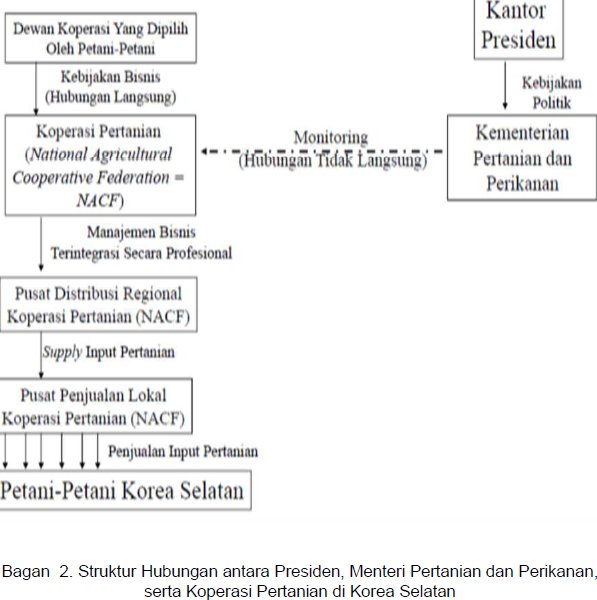
Peranan Koperasi Pertanian untuk memajukan perekonomian Korea Selatan ditunjukan dalam Bagan 3, sedangkan contoh integrasi koperasi peternakan dengan koperasi pertanian (induk) ditunjukan dalam Bagan 4.
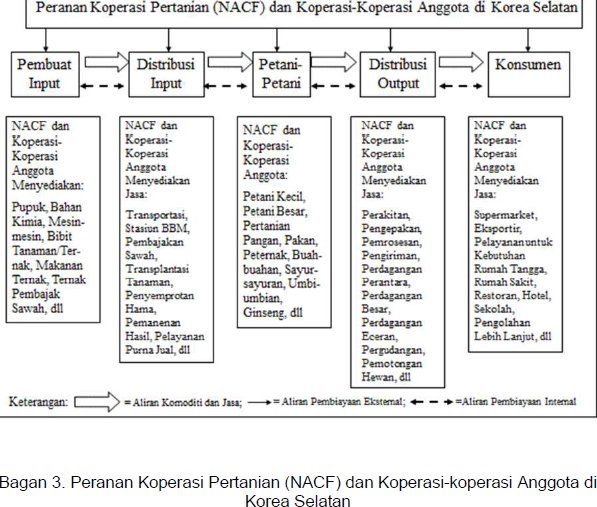

Berbagai fasilitas yang dimiliki oleh Koperasi Pertanian di Korea Selatan pada tahun 2011 ditunjukan dalam Tabel 2.
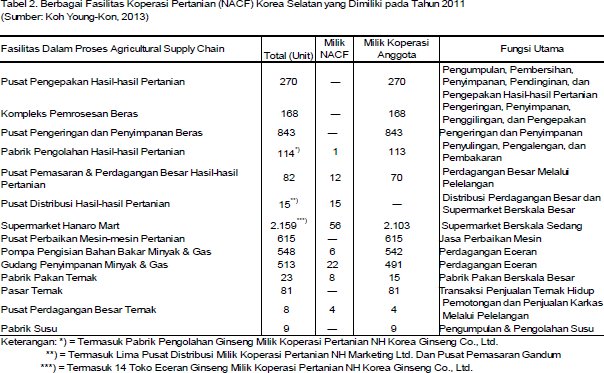
Koperasi Pertanian di Korea Selatan menguasai dan mempraktekan Total Agricultural Supply Chain Management seperti ditunjukan dalam Bagan 5.
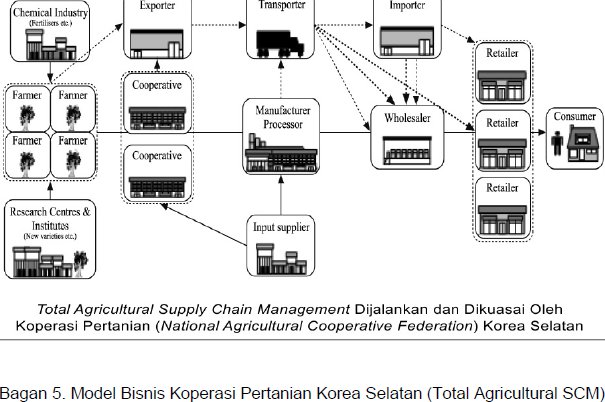
III.2 Gerakan Masyarakat Baru Korea Selatan (Saemaul)
Gerakan Masyarakat Baru (GMB) di Korea Selatan disebut Saemaul. Saemaul yang terdiri dari “Sae” dan “Maul” adalah kombinasi dari dua kata korea yang berarti: Sae (Baru atau Pembaruan) dan Maul (Komunitas), yang berarti Komunitas/Masyarakat Baru atau Pembaruan Komunitas/Masyarakat. Gerakan Masyarakat Baru di Korea Selatan diperkenalkan pada 22 April 1970 oleh Presiden Korea Selatan Park Chung Hee, dan masih berjalan sampai sekarang. Pertama kali Gerakan Masyarakat Baru (GMB) di Korea Selatan ini dimaksudkan untuk memodernisasikan ekonomi pedesaan Korea Selatan berbasiskan pengaturan mandiri (self-governance) melalui koperasi-koperasi pedesaan (semacam Koperasi Unit Desa-KUD di Indonesia, kecuali manajemen yang berbeda sama sekali). Jika koperasi-koperasi di Indonesia dikelola secara parsial, maka koperasi-koperasi di Korea Selatan dikelola secara bisnis terintegrasi (integrated business) dalam kerangka sistem industri Agricultural Lean Supply Chain Management yang sangat efisien, produktif, dan berkualitas, sejak dari industri hulu-on farm-sampai industri hilir. Aktivitas seperti pembibitan, produksi pertanian, agro industry, sampai pemasaran hasil-hasil pertanian dilakukan sepenuhnya oleh Koperasi Pertanian (National Agricultural Cooperative Federation) secara bisnis terintegrasi.
GMB berusaha untuk memperbaiki kesenjangan standar hidup antara daerah perkotaan, yang cepat berkembang karena penerapan strategi industrialisasi berorientasi ekspor, dan desa-desa kecil, yang terus terperosok dalam kemiskinan. Kolaborasi melalui koperasi-koperasi pedesaan terus-menerus mendorong anggota masyarakat terutama di daerah pedesaan (termasuk di perkotaan) untuk berpartisipasi dalam proses pembangunan ekonomi dan industri Korea Selatan.
Tahap awal dari GMB difokuskan pada peningkatan kondisi kehidupan dasar dan lingkungan melalui berbagai proyek-proyek yang berkonsentrasi pada pembangunan infrastruktur pedesaan untuk meningkatkan pendapatan masyarakat pedesaan itu.
Model GMB yang melibatkan koperasi-koperasi di Korea Selatan ditunjukan dalam Bagan 6.
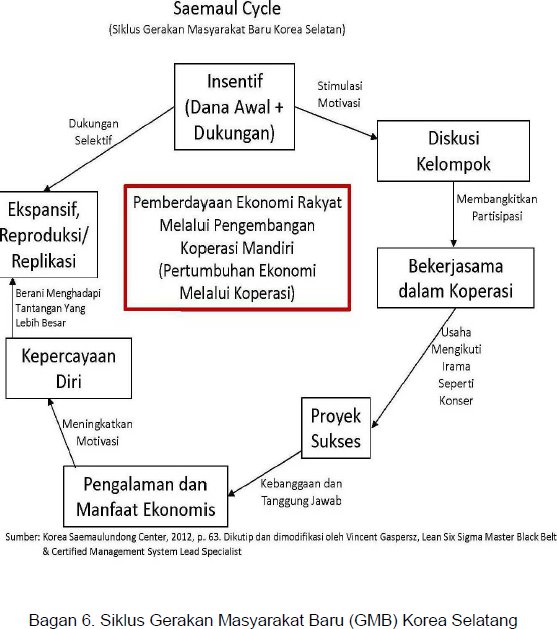
Di samping permodalan dan dukungan Pendidikan, pelatihan, dan sistem informasi manajemen (lihat Bagan 6 tentang Saemaul Cycle), pemerintah Korea Selatan juga membantu sistem administrasi koperasi yang terdiri dari 14 item berikut secara GRATIS:
- Buku Bank
- Deskripsi Umum Desa dan Kekayaan Desa
- Rencana Bisnis
- Buku Kas
- Catatan daftar material yang diterima koperasi
- Dokumen anggaran pengeluaran/pembelanjaan
- Daftar tagihan pihak ketiga kepada koperasi
- Catatan upah di desa
- Minutes of meeting selama periode satu tahun
- Peraturan-peraturan dan ketentuan dari Saemaul (Gerakan Masyarakat Baru)
- Album foto-foto kegiatan
- Catatan kemajuan kerja
- Catatan daftar karyawan/pekerja/anggota-anggota koperasi
- Rencana pemeliharaan hewan atau aktivitas sesuai bidang usaha dari koperasi, dll.
CATATAN: dukungan dari pemerintah ini HANYA untuk meningkatkan kualitas sumber daya manusia dalam pembangunan SDM Desa, TETAPI urusan bisnis, dll yang terkait dengan unit usaha akan bekerja sama dengan koperasi-koperasi lain yang mengacu kepada hubungan sinergitas yang saling menguntungkan dengan konglomerat koperasi NACF (National Agricultural Cooperatives Federation) yang menguasai pasar dari hulu sampai ke hilir seperti ditunjukan dalam Bagan 5 (lihat Bagan 5).
GMB telah diadopsi oleh PBB sebagai salah satu model pembangunan pedesaan yang paling EFISIEN di dunia. Komisi Ekonomi untuk Afrika (Economic Commision for Africa = ECA) telah memutuskan untuk memilih GMB sebagai model dasar untuk Program Modernisasi Pertanian Berkelanjutan dan Transformasi Pedesaan (SMART = Sustainable Modernization of Agriculture and Rural Transformation) pada tahun 2008. Selain itu, GMB ini telah diekspor ke lebih dari 70 negara untuk berbagi pengalaman pembangunan pedesaan di seluruh dunia. Indonesia seyogianya meniru GMB di Korea Selatan, karena pembangunan ekonomi melalui koperasi-koperasi yang mencapai skala usaha ekonomis (economies of scale) dan ruang lingkup ekonomis (economies of scope) merupakan perwujudan dari implementasi Pasal 33 UUD 1945.
Jika implementasi pasal 33 UUD 1945 model Korea Selatan di atas diterapkan di Indonesia, apalagi ditambah KOMITMEN pemerintah untuk menerapkan Good Government Governance mengikuti standar Internasional ISO 9001 yang telah didesain oleh penulis (lihat Bagan 7), maka penulis yakin bahwa Indonesia akan mampu mengejar ketertinggalannya dari Korea Selatan yang memulai pembanguan bersamaan dengan Indonesia.
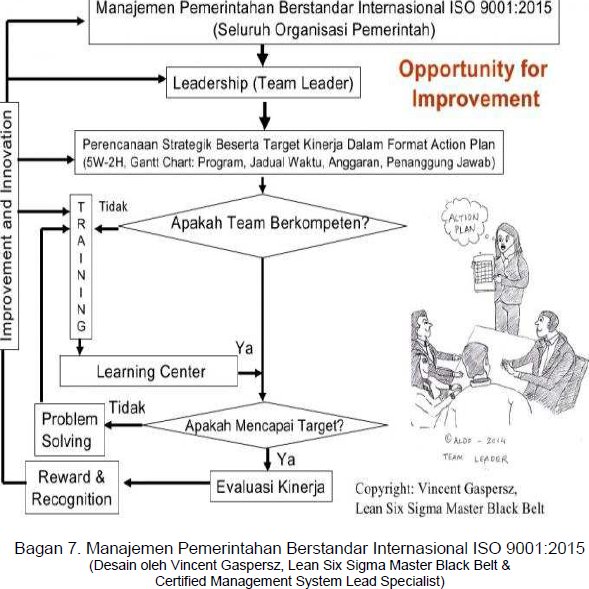
IV. Strategi Membangun Perekonomian NTT Melalui Koperasi-koperasi Yang Mencapai Skala Usaha Ekonomis (Economies of Scale) dan Ruang Lingkup Ekonomis (Economies of Scope)
Pembangunan ekonomi NTT akan maju dan berkembang apabila menekankan pada pembangunan sumber daya manusia melalui wadah koperasi-koperasi yang memenuhi skala usaha ekonomis (economies of scale) dan ruang lingkup ekonomis (economies of scope). Model pembangunan sumber daya manusia NTT ditunjukan dalam Bagan 8.
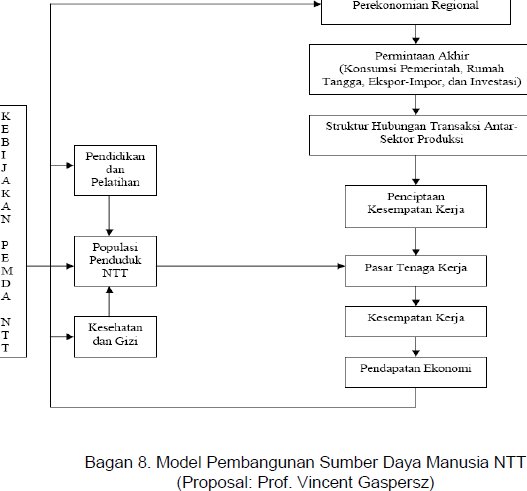
Penjelasan Model Pembangunan Sumber Daya Manusia di Nusa Tenggara Timur:
- Pendekatan yang cocok untuk memecahkan masalah pembangunan sumber daya manusia di NTT, adalah mengintegrasikan bidang-bidang ekonomi, pendidikan dan pelatihan, serta kesehatan dan gizi secara terpadu (terintegrasi) dalam kerangka pendekatan sektoral (sektor-sektor produksi) dan pendekatan regional (kabupaten-kabupaten, kecamatan-kecamatan, dan desa-desa) secara utuh sebagai satu system perekonomian berbasis koperasi-koperasi yang mencapai skala usaha ekonomis (economies of scale) dan ruang lingkup ekonomis (economies of scope).
- Kedua pendekatan ini, sektoral dan regional harus diterapkan secara bersama. Dengan demikian model desain, perencanaan, implementasi, pengendalian, dan peningkatan terus-menerus pembangunan di Nusa Tenggara Timur HARUS selalu mengaitkan dimensi sektoral (sektor-sektor produksi) dengan dimensi spasial/ruang (kabupaten-kabupaten, kecamatan-kecamatan, dan desa-desa).
- Semua kebijakan PEMDA (Pemerintah Daerah) NTT HARUS berorientasi pada peningkatan pendapatan ekonomi masyarakat, pendidikan dan pelatihan masyarakat, serta kesehatan dan gizi masyarakat secara terintegrasi dan terpadu dalam kerangka pendekatan pembangunan sektoral dan regional di atas dalam wadah koperasi-koperasi yang mencapai skala usaha ekonomis dan ruang lingkup ekonomis.
- Berkaitan dengan kebijakan peningkatan pendapatan ekonomi masyarakat, maka HARUS ditumbuhkembangkan perekonomian regional melalui memprioritaskan pengembangan sektor-sektor produksi yang memiliki dampak pengganda pendapatan (income multiplier effect) dan kesempatan kerja terbesar (employment multiplier effect). Semua sektor-sektor produksi yang memiliki karakteristik pengganda pendapatan dan kesempatan kerja ini diakomodasikan ke dalam wadah koperasi-koperasi yang memenuhi skala usaha ekonomis dan ruang lingkup ekonomis.
- Berkaitan dengan kebijakan pendidikan dan pelatihan HARUS diarahkan agar sistem pendidikan dan pelatihan mampu memberikan pengetahuan dan keterampilan yang sesuai dengan kebutuhan pasar tenaga kerja lokal, nasional maupun internasional.
- Berkaitan dengan kebijakan kesehatan dan gizi HARUS memberdayakan masyarakat agar memelihara lingkungan hidup yang sehat dan bersahabat dengan alam sehingga mempertimbangkan sistem manajemen lingkungan yang berkelanjutan. Program-program pembangunan sumber daya manusia HARUS berkaitan dan bersinergi dengan aspek lingkungan di mana masyarakat itu berada sesuai dengan potensi wilayah dalam sektor-sektor produksi yang tergabung dalam sistem perekonomian wilayah berbasis koperasi-koperasi yang mencapai skala usaha ekonomis dan ruang lingkup ekonomis.
Model Strategi SUCCESS membangun NTT selalu mengaitkan integrasi tiga pihak, yaitu: (1) lembaga Pendidikan dan pelatihan, (2) lembaga keuangan dan perbankan, dan (3) koperasi-koperasi yang mencapai skala usaha ekonomis dan ruang lingkup ekonomis sebagai ujung tombak pengembangan perekonomian rakyat NTT. Pemerintah dan DPRD merupakan fasilitator yang mempercepat integrasi ketiga pihak ini seperti ditunjukan dalam Bagan 9.
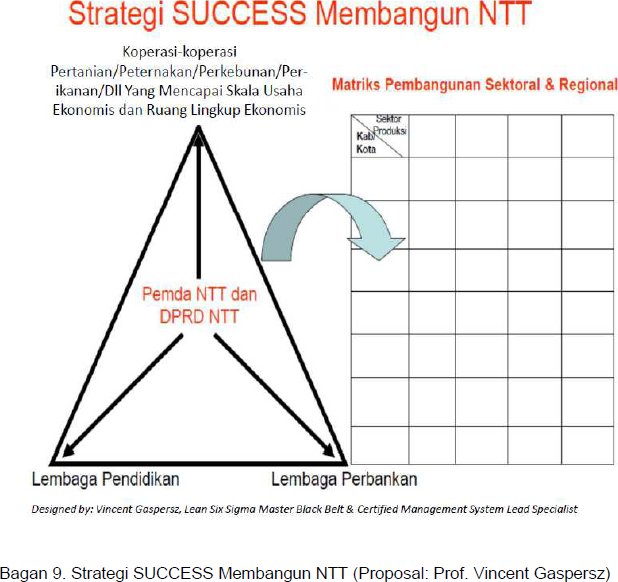
Perlu diperhatikan bahwa koperasi-koperasi yang dimaksudkan dalam Bagan 3 di atas, adalah koperasi-koperasi yang telah mencapai skala usaha ekonomis dan ruang lingkup ekonomis agar koperasi-koperasi itu mampu bersaing di pasar. Di samping itu perlu dipertimbangkan untuk melakukan proses konglomerasi koperasi-koperasi, sehingga mampu mencapai ruang lingkup ekonomis seperti koperasi-koperasi di Korea Selatan. Agar diketahui bahwa meskipun jumlah koperasi di NTT cukup banyak, tetapi koperasi-koperasi itu tidak mencapai skala usaha ekonomis dan ruang lingkup ekonomis, yang berarti koperasi-koperasi yang ada merupakan koperasi usaha kecil yang tidak ekonomis.
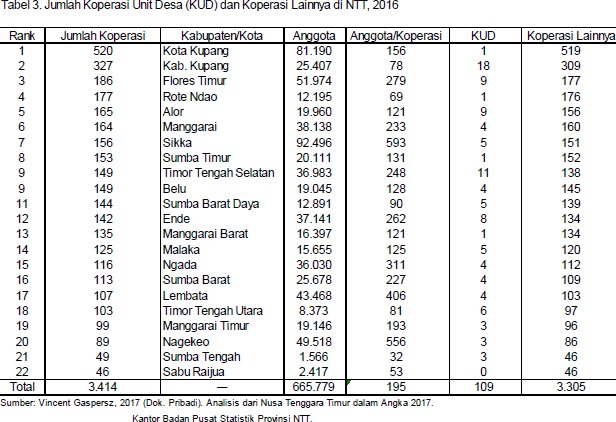
Bagi profesional bisnis: Opportunity is NOWHERE (Kesempatan Tidak Ada Di mana-mana) SELALU dibaca Opportunity is NOW HERE (Kesempatan Ada Di sini Sekarang).
Hasil analisis tentang komoditas pangan yang sangat penting, yaitu BERAS di Provinsi Nusa Tenggara Timur seperti ditunjukan dalam Tabel 4, memunculkan Kesempatan Bisnis Beras yang terbuka lebar bagi Koperasi Konsumsi dan Koperasi Distribusi di Provinsi NTT.
Dengan cara analisis yang sama terhadap berbagai komoditas penting seperti: daging sapi, daging ayam, dll akan memunculkan kesempatan bisnis (Business Opportunity) bagi koperasi-koperasi di NTT untuk mencapai skala usaha ekonomis (economies of scale) dan ruang lingkup ekonomis (economies of scope).
Dari Tabel 4 juga menimbulkan pertanyaan REFLEKSI tentang apa peranan lembaga Pendidikan pertanian di NTT yang “TIDAK MAMPU” meningkatkan produksi pangan lokal (beras) ini, sehingga kontribusi pada pengadaan beras yang berasal dari produksi lokal pada tahun 2016 HANYA sekitar 1,6% (satu koma enam persen) saja?

Berbagai pemikiran di atas akan MAMPU meningkatkan indeks pembangunan manusia (IPM) NTT secara signifikan dibandingkan IPM NTT pada saat sekarang. Indeks Pembangunan Manusia diukur berdasarkan komponen-komponen: kesehatan (umur harapan hidup), komponen pendidikan (angka melek huruf dan lama sekolah), dan komponen pendapatan ekonomi (pengeluaran yang disesuaikan). Indeks Pembangunan Manusia NTT periode 2012-2016 ditunjukan dalam Tabel 5. Sedangkan ketimpangan pembangunan sumber daya manusia di antara kabupaten dan kota di dalam Provinsi NTT ditunjukan dalam Tabel 6.
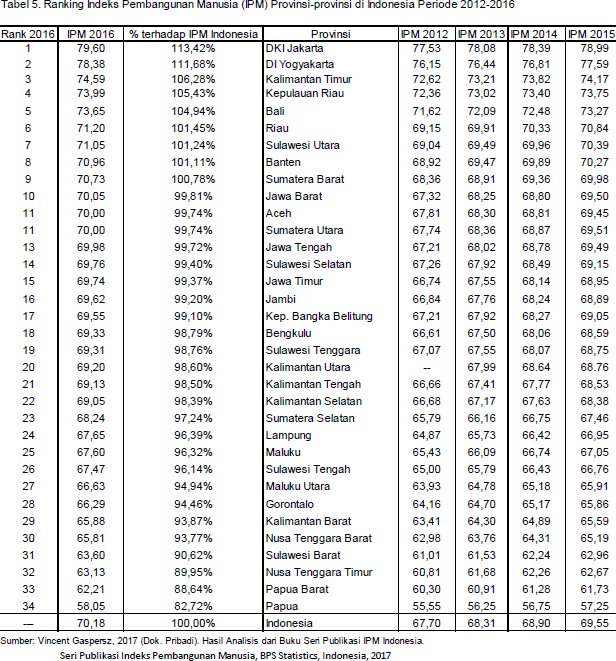
Jika kita melihat IPM Provinsi NTT tahun 2016 sebesar 63,13 kemudian membandingkan dengan IPM Kabupaten/Kota di dalam Provinsi NTT, maka HANYA ada lima kabupaten dan kota yang memiliki IPM di atas rata-rata NTT, yaitu: (1) Kota Kupang (78,14), (2) Ende (65,74), (3) Ngada (65,61), (4) Nagekeo (63,93), dan (5) Sumba Timur (63,22). 17 kabupaten memiliki IPM yang lebih rendah daripada IPM NTT (lihat Tabel 6).
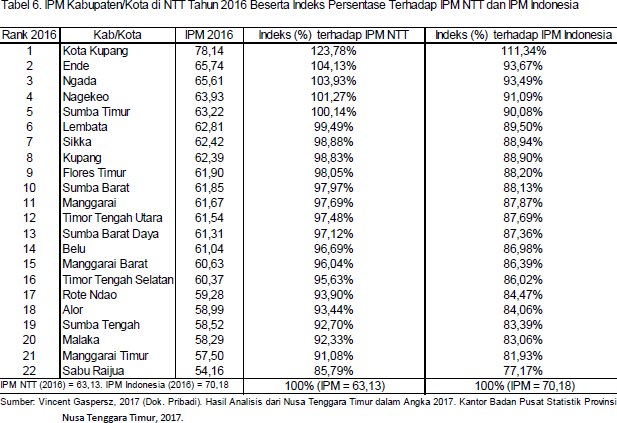
V. Sekilas Tentang Kinerja Koperasi dan Industri di DI Yogyakarta
Meskipun perkembangan koperasi-koperasi di DI Yogyakarta belum sebaik dibandingkan perkembangan koperasi-koperasi di Korea Selatan tetapi perkembangan koperasi dan industri kecil di DI Yogyakarta ini sangat membantu dalam peningkatan ekonomi masyarakat sehingga mampu meningkatkan indeks pembangunan manusia (IPM) DI Yogyakarta untuk mencapai ranking nomor dua di Indonesia. Bagaimanapun konglomerasi koperasi telah ada di Pekalongan, Jawa Tengah, di mana Kospin (Koperasi Simpan Pinjam) Jasa Pekalongan telah mencapai skala usaha ekonomis dan ruang lingkup ekonomis karena telah memiliki asset sekitar Rp. 7 Triliun pada tahun 2016 dengan jumlah anggota koperasi sebanyak 18.375 orang, atau rata-rata asset per anggota adalah Rp. 380.952.381. (lihat: https://ekbis.sindonews.com/read/1189554/34/aset-kospin-jasa-mencapai-rp7-triliun-1489828190)
Beberapa indikator kinerja koperasi dan industri kecil di Yogyakarta pada tahun 2016 ditunjukan dalam Tabel 7.
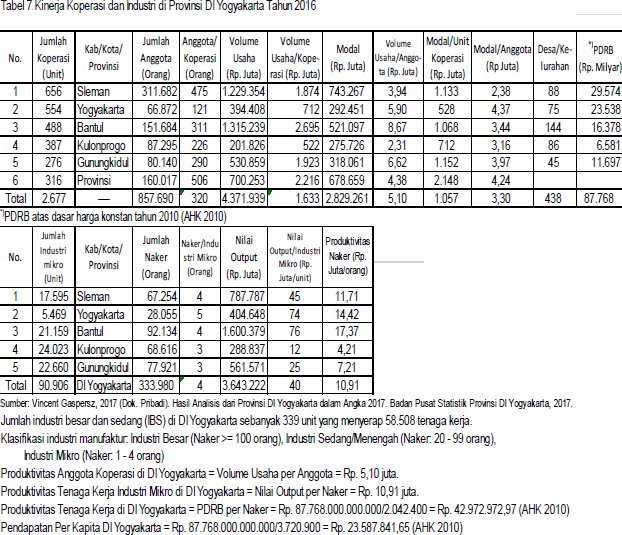
Meskipun pada tahun 2016 pertumbuhan ekonomi Provinsi Nusa Tenggara Timur adalah 5,18% lebih tinggi daripada pertumbuhan ekonomi DI Yogyakarta yang hanya 5,05% TETAPI berbagai indikator kinerja pendidikan dan ekonomi DI Yogyakarta lebih unggul daripada Provinsi Nusa Tenggara Timur seperti ditunjukan dalam Tabel 8.
Hal yang menarik dari Tabel 8 adalah memunculkan kesempatan bisnis untuk mendirikan koperasi-koperasi pertanian yang mencapai skala usaha ekonomis dan ruang lingkup ekonomis sehingga mampu meningkatkan nilai tukar petani seperti yang dilakukan pada koperasi-koperasi pertanian di DI Yogyakarta. Di samping itu peluang mendirikan koperasi-koperasi konsumsi yang layak secara ekonomis, sehingga memunculkan kesempatan kepada anggota-anggota koperasi konsumsi yang mencapai skala usaha ekonomis dan ruang lingkup ekonomis agar di samping melakukan konsumsi juga memperoleh pendapatan dari aktivitas konsumsi itu.
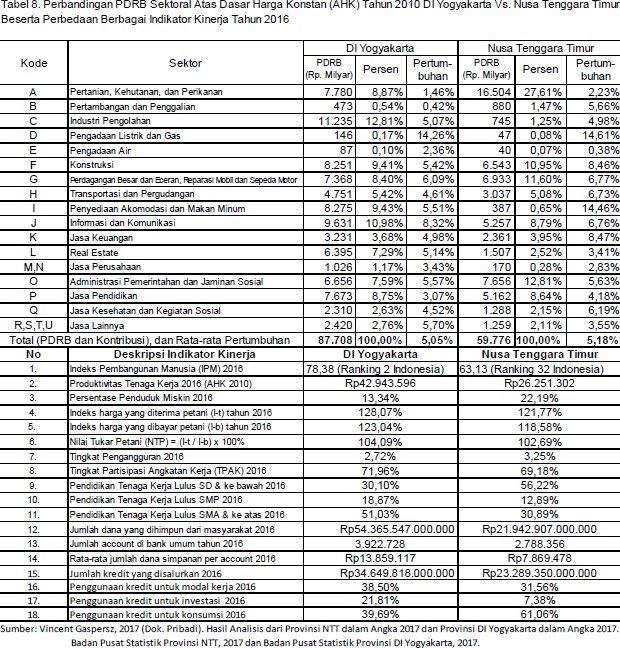
VI. Kesimpulan dan Rekomendasi Manajemen
Strategi peningkatan dan pemerataan pendapatan masyarakat Korea Selatan yang dilakukan melalui koperasi-koperasi yang mengelola bisnis mereka dalam suatu manajemen ke-SISTEM-an industri yang kuat, kapabel, handal, produktif dan berkualitas dapat dijadikan teladan untuk membangun koperasi-koperasi yang mencapai skala usaha ekonomis (economies of scale) dan ruang lingkup ekonomis (economies of scope) baik di Indonesia pada umumnya maupun di Nusa Tenggara Timur pada khususnya.
Agricultural Lean Supply Chain Management di Korea Selatan yang dilakukan melalui koperasi-koperasi pertanian yang memenuhi skala usaha ekonomis dan ruang lingkup ekonomis mulai dari pedesaan sampai perkotaan telah mensejahterakan petani-petani dan tenaga kerja yang terlibat dalam sektor-sektor industri hulu sampai hilir. Sesungguhnya sistem perkoperasian serta model pembangunan di Korea Selatan ini yang sesuai dengan Pasal 33 UUD 1945, sehingga meskipun Korea Selatan tidak memiliki UUD 1945 tetapi mereka jauh lebih maju dari kita di Indonesia. Pembuat kebijakan pembangunan ekonomi dan industri serta pembangunan sumber daya manusia di Indonesia HARUS belajar pada keberhasilan Korea Selatan, sebuah Negara yang sangat miskin pada tahun 1960-1970 TELAH bertransformasi menjadi Negara maju berproduktivitas dan berpendapatan tinggi di Asia.
Pendekatan yang cocok untuk memecahkan masalah pembangunan sumber daya manusia di NTT, adalah mengintegrasikan bidang-bidang ekonomi, pendidikan dan pelatihan, serta kesehatan dan gizi secara terpadu (terintegrasi) dalam kerangka pendekatan sektoral (sektor-sektor produksi) dan pendekatan regional (kabupaten-kabupaten, kecamatan-kecamatan, dan desa-desa) secara utuh sebagai satu sistem perekonomian berbasis koperasi-koperasi yang mencapai skala usaha ekonomis (economies of scale) dan ruang lingkup ekonomis (economies of scope).
Kedua pendekatan ini, sektoral dan regional harus diterapkan secara bersama. Dengan demikian model desain, perencanaan, implementasi, pengendalian, dan peningkatan terus-menerus pembangunan di Nusa Tenggara Timur HARUS selalu mengaitkan dimensi sektoral (sektor-sektor produksi) dengan dimensi spasial/ruang (kabupaten-kabupaten, kecamatan-kecamatan, dan desa-desa).
Hasil analisis terhadap indikator kinerja memunculkan kesempatan bisnis untuk mendirikan koperasi-koperasi pertanian (koperasi produksi pertanian) di Nusa Tenggara Timur yang mencapai skala usaha ekonomis dan ruang lingkup ekonomis sehingga mampu meningkatkan nilai tukar petani seperti yang dilakukan pada koperasi-koperasi pertanian di DI Yogyakarta. Di samping itu peluang mendirikan koperasi-koperasi konsumsi yang layak secara ekonomis, sehingga memunculkan kesempatan kepada anggota-anggota koperasi konsumsi yang mencapai skala usaha ekonomis dan ruang lingkup ekonomis agar di samping melakukan konsumsi juga memperoleh pendapatan dari aktivitas konsumsi itu. Pada akhirnya akan terbentuk konglomerasi koperasi seperti Kospin (koperasi simpan pinjam) Jasa Pekalongan yang pada tahun 2016 telahmemiliki asset senilai Rp. 7 Triliun dengan jumlah anggota sebanyak 18.375 orang atau rata-rata asset per anggota sebesar Rp. 380.952.381.
Salam SUCCESS.
VII. Daftar Pustaka
- Badan Pusat Statistik Provinsi Nusa Tenggara Timur. 2017. Provinsi Nusa Tenggara Timur dalam Angka 2017.
- Badan Pusat Statistik Provinsi DI Yogyakarta. 2017. Provinsi DI Yogyakarta dalam Angka 2017.
- Gaspersz, Vincent., 2011. Ekonomi Manajerial (Managerial Economics), Landasan Analisis dan Startegi Bisnis untuk Manajemen Perusahaan dan Industri. Tri-Al Bros, Bogor.
- Gaspersz, Vincent, 2013. All-in-one 150 Key Performance Indicators and Balanced Scorecard, Malcolm Baldrige, Lean Six Sigma Supply Chain Management. Tri-Al Bros, Bogor.
- Hugos, M. (2003). Essentials of Supply Chain Management. E-Book Edition, John Wiley and Sons, Inc., New Jersey.
- Kaplan, R.S. and David P. Norton. 1996. The Balanced Scorecard—Translating Strategy into Action. Harvard Business School Press, Massachusetts.
- Keel, J., Albert Hawkins, and Lawrence F. Alwin. 1999. Guide to Performance Measurement Management. Governor’s Office of Budget and Planning, USA.
- Lee, Joong Hwa, Jose Arturo Garza-Reyes, Vikas Kumar, Luis Rocha Lona, and Nishikant Mishra. (2013). A Comparative Study of the Implementation Status of Lean Six Sigma in South Korea and the UK. 23rd International Conference on Flexible Automation and Intelligent Manufacturing. Vol 1., Springer International Publishing, Switzerland.
- Sandiford, F. and George Ed Rossmiller. (1996). Many a Slip: Studying Policy Delivery Systems. Paper presented at the Agricultural Economics Society Conference, University of Newcastle-upon-Tyne, 27-30 March 1996.
- Young-Kon, Koh. (2013). An Integrated Value Chain Finance in Agriculture: Experience of Agriculture Cooperative in Korea. Paper presented at the Policy Dialogue Forum on Value Chain Finance in Agriculture, Sep 3-5, 2013, Kathmandu, Nepal.
- World Bank. (2014). 2014 World Development Indicators. The World Bank, Washington DC.
- http://bps.go.id/tab_sub/view.php?kat=1&tabel=1&daftar=1&id_subyek=23¬ab=7
- Website NACF: http://www.nonghyup.com/eng/main/main.aspx
http://en.wikipedia.org/wiki/National_Agricultural_Cooperative_Federation - http://news.okezone.com: Profil Koperasi-koperasi Kelas Dunia, 2009.
- https://ekbis.sindonews.com/read/1189554/34/aset-kospin-jasa-mencapai-rp7-triliun-1489828190
TENTANG Penulis/Pemakalah
Prof. Dr(Eng). Ir. Vincent Gaspersz, M.St, D.Sc, adalah Ahli Teknik Sistem dan Manajemen Industri, Lean Six Sigma Master Black Belt and Certified Management System Lead Specialist.
Ia meraih gelar Sarjana Peternakan (Ir.) dari Universitas Nusa Cendana Kupang, 1979, Magister Sains dalam bidang Statistika Terapan (Master of Science in Applied Statistics) dengan pilihan penerapan pada ekonomi dan perencanaan wilayah dari IPB Bogor dalam waktu kurang dari dua tahun pada tahun 1985. Kemudian ia memperoleh dua gelar Doktor (Dr. dan D.Sc.), yang pertama adalah Doktor dalam bidang Teknik Sistem dan Manajemen Industri dengan meraih indeks prestasi tertinggi IP = 4,0 dari ITB Bandung dalam waktu tiga tahun pada tahun 1991, kemudian yang kedua adalah Doctor of Science in Management of Engineering and Technology dari Southern California University for Professional Studies dengan predikat Summa Cum Laude (GPA = 4.0) pada tahun 2000.
Prof. Vincent Gaspersz memperoleh tiga gelar professional dalam bidang-bidang: Production, Inventory, and Supply Chain Management dari the American Production and Inventory Society (CFPIM = Certified Fellow in Production and Inventory Management, CPIM = Certified in Production Management, CSCP = Certified Supply Chain Professional). Memperoleh lima gelar professional dalam bidang Quality Management dari the American Society for Quality (CMQ/OE = Certified Manager of Quality/Organizational Excellence, CSSBB = Certified Six Sigma Black Belt, CQE = Certified Quality Engineer, CQA = Certified Quality Auditor, CQIA = Certified Quality Improvement Associate). Dua gelar professional dari Registration Accreditation Board USA (CMSS = Certified Management System Specialist, CMSLS = Certified Management System Lead Specialist).
Prof. Vincent Gaspersz telah berpangalaman lebih 26 tahun (sejak 1991) sebagai Designer and Implementer of Integrated Management Systems. Ia telah mempublikasikan 47 buku-buku teks dalam bidang ilmu Ekonomi Manajerial dan Sistem-sistem Manajemen Modern.
Design and Strategic Model Implementation of Cooperative-Based Economic Development with Economies of Scale and Economies of Scope
By: Vincent Gaspersz, Lean Six Sigma Master Black Belt & Certified Management System Lead Specialist
- APICS (www.apics.org) Certified Fellow in Production and Inventory Management (CFPIM) and Certified Supply Chain Professional (CSCP);
- International Quality Federation (www.iqf.org) Six Sigma Master Black Belt (SSMBB);
- ASQ (www.asq.org) Certified Manager of Quality/Organizational Excellence (CMQ/OE), Certified Quality Engineer (CQE), Certified Quality Auditor (CQA), Certified Six Sigma Black Belt (CSSBB), Certified Quality Improvement Associate (CQIA);
- Registration Accreditation Board (www.exemplarglobal.org) Certified Management System Lead Specialist (CMSLS).
Abstract
The strategy of income generation and distribution of South Koreans that is done through cooperatives managing their businesses in a robust, capable, reliable, productive and qualified industrial-system management can be modeled to build cooperatives that achieve economies of scale and economies of scope both in Indonesia in general and in East Nusa Tenggara in particular.
A suitable approach to solve human resource development problems in NTT is to integrate integrated areas of economy, education and training, as well as health and nutrition in integration within the framework of sectoral approach (production sectors) and regional approach (districts, sub-districts, and villages) as a whole as one economic system based on cooperatives that reach economies of scale and economies of scope.
I. Terminology and Definition
- Economic development is the process in which a nation improves the economy, politics, and social well-being of its people. This term has been used by economists, politicians, and others so far. Modernization, especially industrialization, is another term that has been used by many when discussing economic development. While for economic growth, it includes efforts of government policy intervention that are aimed at improving the economy and social welfare of the community through economic growth that is characterized by increased labor productivity and gross domestic product (GDP). Thus, we can state in the economic system, that economic development, which is a process of that economic system, will produce output in the form of economic growth (increase in labor productivity and increase in gross domestic product).
- Cooperative is a joint venture that is owned and run jointly by its members who share the profits or benefits. Charles E. Snyder (President and CEO of National Cooperative Bank, 2016) states that qualified and competitive co-operatives must meet the following seven requirements: (1) Is voluntary and having open membership, (2) Having democratic control of members, (3) Having active economic participation by members, (4) Is autonomous and free, (5) Having education, training and information, (6) Having cooperation among cooperative units, and (7) Having attention to the community.
- Economies of Scale are the cost advantages of a business unit, because that business operates on an output scale that enables the achievement of a decrease in cost per unit of output (average cost) to a minimum. This is because fixed costs will be distributed evenly throughout the scale of that business, so that the Long Run Average Cost (LRAC) will be minimum. These economies of scale exist in the real world, so that each business unit must seek to approach or reach these economies of scale as shown in Chart 1 below.

- Economies of Scope are the efficiency achieved due to the business diversification process that arises when that business combines or integrates related functions (e.g. financial and marketing functions are combined into one) or when the business units integrate with each other (e.g. the output of one business unit becomes the input for another business unit in the business process linkage; for example: beef cattle farm unit is integrated with beef processing unit to produce frozen meat products or others). The conglomeration process in the business units is the attempt to reach Economies of Scope. Cross Selling of various products is also an effort to reach the Economies of Scope, because sales of various types of products will be more profitable than the sale of only one product. Economies of Scope can also operate through distribution efficiency; for example, the vessel ship will be flexible and efficient when transporting various types of products to be transported to multiple locations rather than when transporting only one product to one location. An example of Economies of Scope is shown in Chart 2.

II. The Success of Economic Development through Cooperatives (Learning from South Korea)
South Korea became independent on August 15, 1945 (although it only began to be celebrated on August 15, 1948) while Indonesia became independent on August 17, 1945. Why should Indonesia be compared to South Korea, whose progress has far surpassed Indonesia? Because these two countries began development simultaneously and became independent also in almost the same time. These two countries, Indonesia and South Korea were the poorer countries when starting up their economic and industrial developments (the difference was Indonesia was rich in natural resources vs. South Korea that was poor in natural resources). But these two countries are different like the earth and the sky in 2017.
South Korea in 1960 was a poor country (per capita income of US$79) with no adequate natural resources. But through the implementation of an export-oriented industrialization strategy that is supported by the focus of human resources development within an intensive and widespread cooperative container, the productivity South Korea’s national human resources increases dramatically; thus, bringing South Korea’s 2016 per capita income to have been US$25,458.90
(https://tradingeconomics.com/south-korea/gdp-per-capita), up by about 322 times in 56 years.
Whereas Indonesia, which has abundant natural resources, in 2016 has only per capita income of US$3,974.10
(https://tradingeconomics.com/indonesia/gdp-per-capita).
In the 1960s, Indonesia, Malaysia and South Korea started development with the equal status of being poor country. The difference was: Indonesia were rich in natural resources, Malaysia was adequate in natural resources, and South Korea was poor in natural resources. But in development, because of the tremendous growth factor in human resource productivity, South Korea has turned into a high-income country, while Indonesia has turned into a middle-income country. Analysis by Vincent Gaspersz (2014) suggests that the factor that bring about the welfare of a country’s people depend on the increased productivity of human resources, NOT the ownership of natural resources. South Korea’s (highest), Malaysian (medium), and Indonesian (low) human resource productivities during the economic development period of 1967-2012 is shown in Chart 3.

The World Bank classifies countries in the world as follows:
- Low-income countries that have per capita income of US$975 or less.
- Lower-middle-income countries that have per capita income from US$976 to US$3,855.
- Upper-middle-income countries that have per capita income from US$3,856 to US$11,905.
- High-income countries that have per capita income of over US$11,906.
Indonesia, with abundant natural resources, in 2012 only generated GNP/Gross National Product of US$844 billions, while South Korea, with poor natural resources, were capable of producing GNP of US$1,133 billions (US$1.13 trillions) or about 1.34 times of Indonesia’s GNP.
The percentage of poor people in South Korea earning <= US$2.5/day = 0%, as well as the percentage of poor people earning US$10/day is zero percent.
Looking further at health development in South Korea, based on World Bank data (2014), infant mortality rate (under five years old) in South Korea was 5/1000 births; while in Indonesia, it was 32/1000 births. Maternal mortality rate in South Korea: 16/100.000; while in Indonesia: 220/100.000. Life expectancy in South Korea was 81 years old, while in Indonesia was 71 years old.
What about education development in South Korea vs. in Indonesia? Data from the World Bank (2014) shows that the percentage of the population who got higher education in South Korea was 17.9%; while Indonesia, it was only 1.17%. The percentage of middle-educated population in South Korea was 36.8%; while in Indonesia, it was only 11.1%.
Regarding the savings rate of the population in South Korea vs. in Indonesia: the percentage of population who saved in South Korea was 46.9%; while in Indonesia, it was only 15.3%.
Furthermore, the index of Worldwide Governance Indicators Average (WGIA) in South Korea was +0.76 (positive); while in Indonesia, it was -0.46 (negative). World Bank compiles WGIA based on six key indicators which results in index numbers from negative 2.5 (the worst) to positive 2.5 (the best). The six key indicators are: (1) Democracy and Accountability, (2) Political Stability and Absence of Violence, (3) Government Effectiveness, (4) Quality of Regulation, (5) Law Enforcement, and (6) Control of Corruption.
Based on World Bank data (2014), it is known that the WGIA index from Indonesia of -0.46 (negative 0.46) is almost the same as the Philippines (-0.49), Mali (-0.49), Boznia & Herzegovina (-0.43), and Tanzania (-0.36).
The countries with the worst WGIA Index were: Somalia (-2.30), Afghanistan (-1.75), Sudan (-1.60), Zimbabwe (-1.47), and Iraq (-1.34). While the countries with the best WGIA Index were: Denmark (+1,86), Finland (+1,85), New Zealand (+1,83), Sweden (+1,80), Switzerland (+1,71) , Netherlands (+1,71), Norway (+1,70), Australia (+1,63), Canada (+1,62), Singapore (+1,47), and Germany (+1,42).
Why can South Korea progress very rapidly than Indonesia? It turns out the economic development strategy through cooperatives that have economies of scale and economies of scope along with the following New People Movement program are factors that advance South Korea.
III.1 Agricultural Cooperatives (NACF) in South Korea
South Korea began development through massive Land Reform, then established National Agricultural Cooperative Federation on August 15, 1961. If we hear the word cooperative in South Korea , do not imagine it like a cooperative in Indonesia, which also always faces the mismanagement problems and the mistrust from the community towards the cooperative, as a cooperative is still bing treated as a small-and-medium enterprise (SME).
The number of cooperatives in South Korea in February 2012 included 1,167 main branches and 3,306 cooperative units. There were Regional Cooperatives (968); Cooperatives of Agricultural Commodities for fruits (25 pieces), vegetables (17 pieces), horticulture (3 pieces); Regional Livestock Cooperatives (118 units); Milk Cooperatives (13), Pig Cooperatives (7), Poultry Cooperatives (2), Beekeeping Cooperative (1), Rabbit and Deer Cooperative (1); and Cooperatives of Ginseng Commodity (12 pieces).
South Korea’s Agriculture Cooperatives (NACF) have their own line of businesses: banking and insurance, suppliers and marketing of agriculture, livestock suppliers and marketing, services. They had 2,446,836 members in 2011 and 15,262,611 associate members.
Furthermore, cooperatives in South Korea should not be imagined like Small Medium Enterprises (SMEs) in Indonesia, because the sales revenues of those cooperatives exceed the conglomerates’ in Indonesia. By comparison, in 2014, revenues from NACF were USD$63.76 billions or equivalent to +/- Rp848 trillions. This makes NACF the world’s number 1 for cooperatives in the agricultural and food industries.
In comparison, sales revenues from South Korean conglomerates: Samsung & LG Electronics in 2014 were respectively around US$195.88 billions (+/- Rp2,605 trillions) and US$55.91 billion (+/- Rp744 trillions). This means sales of South Korea’s Agriculture Cooperatives in 2014 were about 114 percent less than LG Electronics’ sales or about 32.6 percent more than Samsung’s sales in 2014.
If we look at Indonesia’s foreign reserves as of December 2014 which were only about US$100.7 billions (+/- Rp1,339 trillions) and its total exports of oil-and-gas and non-oil-and-gas in 2014, which were only about US$176.29 billions (+/- Rp2,345 trillions), it appears that Indonesia’s total exports in 2014 were lower (about 70 percent) than the sales of two South Korean giants (Samsung & LG), which amounted to approximately US$251.79 billions (+/- Rp3,349 trillions). Or when compared to the sales of the South Korea’s Agricultural Cooperatives in 2014 of about US$63.78 billions (+/- Rp858 trillions), then the sales from South Korea’s agricultural cooperatives were equal to 36.2 percent of Indonesia’s total oil and gas exports in 2014.
The list of the top 20 cooperatives in the world in agriculture and food industry in 2014 is shown in Table 1.

The government’s attention to cooperatives in South Korea is enormous because those cooperatives make a significant contribution to the economic growth and equal distribution of South Koreans’ incomes. The relationship between the President, the Minister of Agriculture and Fisheries, and the Agricultural Cooperatives in South Korea is very clear and structured from the urban centers to the villages. South Korean government does NOT manage South Korean cooperatives; they are professionally managed and driven as independent business units as shown in Chart 2. If the agricultural marketing system in Indonesia still maintains a traditional system with a long marketing chain: Farmers (Producer) – Collecting Traders (Wholesalers) – Senders (Wholesalers) – Large Traders – Retailers – Consumers; then in South Korea, through agricultural cooperatives, it has been shortened to: Farmers (Farmer Producers Cooperatives) – Agriculture Proccesing Centers – Agriculture Marketing Complexes (Supermarkets owned by Agricultural Cooperatives) – Consumers.

The roles of agricultural cooperatives to promote South Korea’s economy is shown in Chart 3, while the example of integration of farming cooperatives with agricultural (parent) cooperatives is shown in Chart 4.


The various facilities owned by the Agricultural Cooperatives in South Korea in 2011 are shown in Table 2.

The Agricultural Cooperatives in South Korea master and practice Total Agricultural Supply Chain Management as shown in Chart 5.

III.2 New Community Movement of South Korea (Saemaul)
The New Community Movement (NCM) in South Korea is called Saemaul. Saemaul, consisting of “Sae” and “Maul”, is a combination of two Korean words meaning: Sae (New or Reform) and Maul (Community), meaning New Community or Community Renewal. The New Community Movement in South Korea was introduced on April 22, 1970 by South Korean President Park Chung Hee, and is still running even now. The New Community Movement (NCM) in South Korea was intially intended to modernize South Korea’s rural economy based on self-governance through rural cooperatives (kind of like Village Cooperative Units in Indonesia, except with different management altogether). If the cooperatives in Indonesia are managed partially, then the cooperatives in South Korea are managed in integrated business within the most efficient, productive, and qualified Agricultural Lean Supply Chain Management framework of industrial systems from the upstream-on farm to the downstream industry. Activities such as transplantation, agricultural production, agro industry, to the marketing of agricultural products are undertaken entirely by the Agricultural Cooperatives (National Agricultural Cooperative Federation) in integrated business manner.
NCM seeks to improve the standard of living gap between urban areas, which are rapidly evolving due to the application of export-oriented industrialization strategy, and small villages, which continue to fall into poverty. Collaboration through rural cooperatives continually encourages community members, especially in rural (including urban) areas to participate in South Korea’s economic and industrial development process.
The initial phase of NCM is focused on improving basic living condition and environment through various projects that concentrate on rural infrastructure development to increase the income of that rural community.
NCM model involving cooperatives in South Korea is shown in Chart 6.

Di samping permodalan dan dukungan Pendidikan, pelatihan, dan sistem informasi manajemen (lihat Bagan 6 tentang Saemaul Cycle), pemerintah Korea Selatan juga membantu sistem administrasi koperasi yang terdiri dari 14 item berikut secara GRATIS:
In addition to the capital and the supports of education, training and management information systems (see Chart 6 on Saemaul Cycle), South Korean government also assists the administration system of cooperatives, which consists of 14 items, GRATIS:
- Bank Account Book
- General Description of the Village and the Village’s Wealth
- Business Plan
- Cash book
- Note of the list of materials received by the cooperative
- Document of expenditure budget
- List of third party invoices to cooperatives
- Note of wages in the village
- Minutes of meeting for a period of one year
- The rules and regulations of Saemaul (New Community Movement)
- Album containing photos of activities
- Note of progress of work
- Note of the list of employees/workers/members of the cooperative
- Animal maintenance plan or activity plan according to the line of business of the cooperative, etc.
NOTE: this support from the government is ONLY to improve the quality of human resources in the HR development of villages. HOWEVER, business affairs, etc., related to the business unit will cooperate with other cooperatives referring to the mutually beneficial synergic relationship with the NACF cooperative conglomerate (National Agricultural Cooperatives Federation) which dominates the market from the upstream to the downstream as shown in Chart 5 (see Chart 5).
NCM has been adopted by the UN as one of the most EFFICIENT rural development models in the world. The Economic Commission for Africa (ECA) decided to select NCM as the basic model for its Sustainable Modernization and Rural Transformation (SMART) program in 2008. In addition, this NCM has been exported to over 70 countries in order to share rural development experiences around the world. Indonesia should imitate NCM in South Korea, because the economic development through cooperatives that reach economies of scale and economies of scope is a manifestation of the implementation of Article 33 of the 1945 Constitution.
If the implementation of Article 33 of the 1945 Constitution of the South Korean model above is applied in Indonesia, moreover with the government’s COMMITMENT to implement Good Governance following the International Standard of ISO 9001 which has been designed by the author (see Chart 7), the author believes that Indonesia will be able to catch up to South Korea that started its development in conjunction with Indonesia.

IV. Strategy to Build NTT’s Economy Through Cooperatives That Achieve Economies of Scale and Economies of Scope
The economic development of NTT will work when it emphasizes the development of human resources through the container of cooperatives that meet economies of scale and economies of scope. NTT’s human resource development model is shown in Chart 8.

Explanation of Human Resource Development Model in East Nusa Tenggara (NTT):
- A suitable approach to solve the human resource development problems in NTT is to integrate areas of economy, education and training, health and nutrition within the framework of sectoral approach (production sectors) and regional approach (districts, sub-districts, and villages) as a whole as one economic system based on cooperatives that reach economies of scale and economies of scope.
- Both of these approaches, sectoral and regional, should be applied together. Thus, the model of design, planning, implementation, control and continuous improvement of development in East Nusa Tenggara MUST always link the sectoral dimensions (production sectors) with the spatial dimensions (districts, sub-districts, and villages).
- All NTT’s Local Government policies should be oriented towards improving the community’s economic income, education and training, and health and nutrition in integrated manner within the framework of the sectoral and regional development approaches above in the container of cooperatives that achieve economies of scale and economies of scope.
- In relation to the policy of increasing the economic income of the community, then the regional economy MUST be developed through prioritizing the development of production sectors that have income multiplier effect and employment multiplier effect. All production sectors that possess these characteristics of income and employment multipliers should be accommodated into container of cooperatives that meet the economies of scale and economies of scope.
- In relation to education and training policies, they MUST be directed to ensure that the education and training system is capable of providing the knowledge and skills relevant to the needs of the local, national and international labor markets.
- In relation to health and nutrition policies, they MUST empower communities to maintain healthy and nature-friendly living environment so as to consider sustainable environmental management systems. Human resource development programs MUST relate and synergize with the environmental aspects in which those people are located in accordance with regional potential within the production sectors that are incorporated in regional economic systems based on cooperatives that achieve economies of scale and economies of scope.
The SUCCESS Strategic Model to build NTT always connects the integration of three parties, namely: (1) Education and training institutions, (2) financial institutions and banks, and (3) cooperatives that achieve economies of scale and economies of scope as the spearhead of NTT people’s economic development. Government and the Regional People’s Representative Assembly are facilitators who accelerate the integration of these three parties as shown in Chart 9.

It should be noted that the cooperatives referred to in Chart 3 above are cooperatives that have achieved economies of scale and economies of scope in order to enable them to compete in the market. In addition, consideration should be given to the conglomeration of cooperatives, so as to achieve economies of scope like the cooperatives in South Korea. Note that although the number of cooperatives in NTT is quite a lot; however those cooperatives do not reach economies of scale and economies of scope, which means that the existing cooperatives are uneconomical small business cooperatives.

For business professionals: “Opportunity is NOWHERE” is always read “Opportunity Is Now Here”.
The most important analysis of food commodity, which is RICE in East Nusa Tenggara Province as shown in Table 4, raises the Rice Business Opportunity that is wide open for Consumer Cooperatives and Distribution Cooperatives in NTT Province.
By way of the similar analysis of other important commodities, such as beef, chicken meat, etc., it will create business opportunity for cooperatives in NTT to achieve economies of scale and economies of scope.
From Table 4, it also raises the REFLECTIVE question about what is the role of agricultural education institutions in NTT? – who are “UNABLE” to increase this local food production (rice), thus the contribution to the procurement of rice derived from local production by 2016 was ONLY about 1.6% (one point six percent) only.

Various ideas above will be able to significantly increase NTT’s human development index (HDI) compared to NTT’s HDI at the present time. The Human Development Index is measured by the components of: health (life expectancy), education (literacy rate and length of schooling), and economic income (adjusted expenditure). NTT’s Human Development Index for the period 2012-2016 is shown in Table 5. Whereas the inequality of human resource development among districts and cities within NTT is shown in Table 6.

If we look at the HDI of NTT Province in 2016 of 63.13 and then compare that to NTT’s Districts/Cities’ HDIs, then there are ONLY five districts and cities that have HDI above the average of NTT’s HDI, namely: (1) Kupang City (78.14), (2) Ende (65.74), (3) Ngada (65.61), (4) Nagekeo (63.93), and (5) East Sumba (63.22). 17 districts have lower HDIs than NTT’s HDI (see Table 6).

V. A Glance About The Performance of Cooperatives and Industries in DI Yogyakarta
Although the development of cooperatives in DI Yogyakarta is not as good as the development of cooperatives in South Korea; but this development of small cooperatives and industries in DI Yogyakarta is very helpful in improving the communities’s economy so as to increase the index of human development (HDI) of DI Yogyakarta to achieve second ranked (number two) in Indonesia. However conglomeration of cooperatives has already existed in Pekalongan, Central Java, where Pekalongan Kospin Service (saving and loan cooperative) has reached economies of scale and economies of scope because it already had assets of about Rp7 trillions in 2016 with the number of cooperative members as many as 18,375 people, or average assets per member of Rp380,952,381. (see: https://ekbis.sindonews.com/read/1189554/34/aset-kospin-jasa-mencapai-rp7-triliun-1489828190)
Several performance indicators of small cooperatives and industries in Yogyakarta in 2016 are shown in Table 7.

Although in 2016 the economic growth of East Nusa Tenggara Province was 5.18% higher than the economic growth of DI Yogyakarta, which was only 5.05%, BUT the various indicators of education and economic performance of DI Yogyakarta were still superior to East Nusa Tenggara Province’s as shown in Table 8.
The interesting thing about Table 8 is that it raises business opportunity to establish agricultural cooperatives that achieve economies of scale and economies of scope so as to be able to promote the exchange rate of farmers as what they have done in agricultural cooperatives in DI Yogyakarta. In addition, there is the opportunity to establish economically viable consumption cooperatives; thus raising the opportunity for the members of the consumption cooperatives to achieve economies of scale and economies of scope who are in addition to consuming are also earning income from those consumption activities.

VI. Conclusion and Management Recommendations
South Korea’s income generation and distribution strategy through cooperatives that manage their businesses in a robust, capable, reliable, productive and qualified industrial-system management can be an example to build cooperatives that achieve economies of scale and economies of scope both in Indonesia in general and in East Nusa Tenggara in particular.
Agricultural Lean Supply Chain Management in South Korea that is conducted through agricultural cooperatives that meet the economies of scale and economies of scope from rural to urban areas has increased the welfare of farmers and workers involved from the upstream to the downstream industrial sectors. Indeed, this cooperative system and development model in South Korea is in accordance with Article 33 of the 1945 Constitution, so that although South Korea does not have the 1945 Constitution, they are still farther ahead compared to us in Indonesia. Policymakers of economic and industrial development and human resource development in Indonesia MUST learn on the success of South Korea – a very poor country in 1960-1970 that has transformed into a high-productivity and high-income developed country in Asia.
A suitable approach to solving human resource development problems in NTT is to integrate the areas of economy, education and training, health and nutrition within the framework of sectoral (production sectors) and regional approaches (districts, sub-districts, and villages) as a whole as one economic system based on cooperatives that reach the economies of scale and the economies of scope.
Both of these approaches, sectoral and regional, should be applied together. Thus, the model of design, planning, implementation, control and continuous improvement of development in East Nusa Tenggara MUST always link the sectoral dimensions (production sectors) with the spatial dimensions (districts, sub-districts, and villages ).
The result of the analysis of the performance indicators raises the business opportunity to establish agricultural cooperatives (cooperatives of agricultural production) in East Nusa Tenggara that reach economies scale and economies of scope so as to be able to increase the exchange rate of farmers as what have been done in agricultural cooperatives in DI Yogyakarta. In addition, the opportunity to establish economically viable consumption cooperatives raises the opportunity for the members of the consumption cooperatives to achieve economies of scale and economies of scope so that in addition to consuming, they also earn income from consumption activity. In the end, it will form a cooperative conglomerate like Pekalongan Kospin Services (savings and loan cooperative) that, in 2016, had an asset worth of Rp7 trillions with a total membership of 18,375 people or the average of assets per member of Rp380,952,381.
Best Regards for SUCCESS.
VII. Bibliography
- Badan Pusat Statistik Provinsi Nusa Tenggara Timur. 2017. Provinsi Nusa Tenggara Timur dalam Angka 2017.
- Badan Pusat Statistik Provinsi DI Yogyakarta. 2017. Provinsi DI Yogyakarta dalam Angka 2017.
- Gaspersz, Vincent., 2011. Ekonomi Manajerial (Managerial Economics), Landasan Analisis dan Startegi Bisnis untuk Manajemen Perusahaan dan Industri. Tri-Al Bros, Bogor.
- Gaspersz, Vincent, 2013. All-in-one 150 Key Performance Indicators and Balanced Scorecard, Malcolm Baldrige, Lean Six Sigma Supply Chain Management. Tri-Al Bros, Bogor.
- Hugos, M. (2003). Essentials of Supply Chain Management. E-Book Edition, John Wiley and Sons, Inc., New Jersey.
- Kaplan, R.S. and David P. Norton. 1996. The Balanced Scorecard—Translating Strategy into Action. Harvard Business School Press, Massachusetts.
- Keel, J., Albert Hawkins, and Lawrence F. Alwin. 1999. Guide to Performance Measurement Management. Governor’s Office of Budget and Planning, USA.
- Lee, Joong Hwa, Jose Arturo Garza-Reyes, Vikas Kumar, Luis Rocha Lona, and Nishikant Mishra. (2013). A Comparative Study of the Implementation Status of Lean Six Sigma in South Korea and the UK. 23rd International Conference on Flexible Automation and Intelligent Manufacturing. Vol 1., Springer International Publishing, Switzerland.
- Sandiford, F. and George Ed Rossmiller. (1996). Many a Slip: Studying Policy Delivery Systems. Paper presented at the Agricultural Economics Society Conference, University of Newcastle-upon-Tyne, 27-30 March 1996.
- Young-Kon, Koh. (2013). An Integrated Value Chain Finance in Agriculture: Experience of Agriculture Cooperative in Korea. Paper presented at the Policy Dialogue Forum on Value Chain Finance in Agriculture, Sep 3-5, 2013, Kathmandu, Nepal.
- World Bank. (2014). 2014 World Development Indicators. The World Bank, Washington DC.
- http://bps.go.id/tab_sub/view.php?kat=1&tabel=1&daftar=1&id_subyek=23¬ab=7
- Website NACF: http://www.nonghyup.com/eng/main/main.aspx
http://en.wikipedia.org/wiki/National_Agricultural_Cooperative_Federation - http://news.okezone.com: Profil Koperasi-koperasi Kelas Dunia, 2009.
- https://ekbis.sindonews.com/read/1189554/34/aset-kospin-jasa-mencapai-rp7-triliun-1489828190
ABOUT Author
Prof. Dr(Eng). Ir. Vincent Gaspersz, M.St, D.Sc, is a Systems Management and Industrial Management Expert, Lean Six Sigma Master Black Belt and Certified Management System Lead Specialist.
He holds a Bachelor’s Degree in Animal Husbandry (BSc.) from Nusa Cendana University Kupang, 1979; Master of Science in Applied Statistics majoring in applied economics and regional planning from IPB Bogor (completed in less than two years), 1985. He has also obtained two Doctoral degrees (Dr. and D.Sc.). The first of which is a Doctorate in Industrial Systems and Management by achieving the highest achievement index GPA = 4.0 from ITB Bandung in 1991; then the second is Doctor of Science in Management of Engineering and Technology from Southern California University for Professional Studies with Summa Cum Laude (GPA = 4.0) in 2000.
Prof. Vincent Gaspersz has three professional degrees in the areas of: Production, Inventory, and Supply Chain Managements from the American Production and Inventory Society (CFPIM = Certified Fellow in Production and Inventory Management, CPIM = Certified in Production Management, CSCP = Certified Supply Chain Professional). He obtains five professional degrees in Quality Management from the American Society for Quality (CMQ/OE = Certified Manager of Quality/Organizational Excellence, CSSBB = Certified Six Sigma Black Belt, CQE = Certified Quality Engineer, CQA = Certified Quality Auditor, CQIA = Certified Quality Improvement Associate). And he has two professional degrees from the Registration Accreditation Board USA (CMSS = Certified Management System Specialist, CMSLS = Certified Management System Lead Specialist).
Prof. Vincent Gaspersz has spent over 26 years (since 1991) as a Designer and Implementer of Integrated Management Systems. He has published 47 textbooks in the fields of Managerial Economics and Modern Management Systems.










